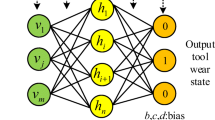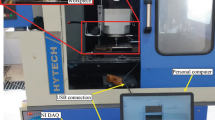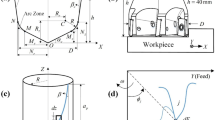Abstract
Cutting tool wear monitoring (TWM) plays a significant role because it guarantees the machined surface integrity. Therefore, the present article proposed a TWM system using Bayesian optimized-support vector regression (BO-SVR) analysis. This objective was realized by acquiring machined surface texture video during machining from an in-situ CMOS camera, and subsequently, analyzing it by feature extraction, selection, predictive model training, model hyperparameters optimization, and model testing and validation. To develop an in-process TWM system, machined surface video is acquired during the machining process, and analyzed using Gabor wavelet (GW) and grey level co-occurrence matrix (GLCM) to extract the information related to roughness, feed marks, and waviness of texture. The significant features are selected using the fisher discriminant ratio (FDR) analysis. The in-process TWM system is trained using the FDR selected features and the predictive model hyperparameters such as C, gamma, epsilon, and kernel type are optimized using the Bayesian optimization algorithm, and their optimized results are 99.51, 0.55, 0.01186, and RBF. An optimized hyperparameters are used to establish an accurate and reliable in-process TWM system. The prediction model accuracy is compared with experimentally measured tool wear, the proposed BO-SVR model can predict tool wear with an RMSE of 0.026494.











Similar content being viewed by others
Data availability
The authors confirm that the data supporting the findings of this study are available within the article [and/or] its supplementary materials.
Code availability
Code will made available from the corresponding author on reasonable request.
Abbreviations
- CMOS:
-
Complementary metal–oxide semiconductor
- FDR:
-
Fisher discriminant ratio
- SVR:
-
Support vector regression
- RMSE:
-
Root mean square error
- TWM:
-
Tool wear monitoring
- BO:
-
Bayesian optimization
- GLCM:
-
Grey level co-occurrence matrix
- MLPNN:
-
Multilayer perceptron neural network
- WNN:
-
Wavelet neural network
- HMM:
-
Hidden Markov model
References
Bhattacharyya, P., Sengupta, D., Mukhopadhyay, S.: Cutting force-based real-time estimation of tool wear in face milling using a combination of signal processing techniques. Mech. Syst. Signal Process. 21(6), 2665–2683 (2007)
Jaffery, S. H., Khan, M., Sheikh, N. A., Mativenga, P.: Wear mechanism analysis in milling of Ti-6Al-4V alloy. Proc. Inst. Mech. Eng. Part B J. Eng. Manuf. 227(8), 1148–1156 (2013).
Chen, B., Chen, X., Li, B., He, Z., Cao, H., Cai, G.: Reliability estimation for cutting tools based on logistic regression model using vibration signals. Mech. Syst. Signal Process. 25(7), 2526–2537 (2011)
Diaz-Rozo, J., Bielza, C., Larrañaga, P.: Machine-tool condition monitoring with Gaussian mixture models-based dynamic probabilistic clustering. Eng. Appl. Artif. Intell. 89(December 2019), 103434 (2020).
Mikolajczyk, T., Paczkowski, T., Kuntoglu, M., Patange, A. D., Binali, R.: Research on Using an unconventional tool for increasing tool life by selective exchange of Worn Cutting Edge. Appl. Sci. 13(1), 460 (2023). https://doi.org/10.3390/app13010460.
Atli, A.V., Urhan, O., Ertürk, S., Sönmez, M.: A computer vision-based fast approach to drilling tool condition monitoring. Proc. Inst. Mech. Eng. Part B J. Eng. Manuf. 220(9), 1409–1415 (2006).
Mulpur, S.B., Thella, B.R. A PCA-Integrated OGM (1, N) predictive model for in-process tool wear prediction based on continuous monitoring of multi-sensorial information. J Fail. Anal. and Preven. 22, 2199–2208 (2022). https://doi.org/10.1007/s11668-022-01499-2.
Sarat, M., Thella, B., Rao, B.: Real-time cutting tool condition assessment and stochastic tool life predictive models for tool reliability estimation by in-process cutting tool vibration monitoring. Int. J. Interact. Des. Manuf. (2022).
Erdi, M., Munish, K., Gupta, K., Li, Z., Krolczyk, G.M., Kuntoğlu, M.: Indirect monitoring of machining characteristics via advanced sensor systems : a critical review. Springer, London (2022)
Babu, M. S., Rao, T. B. (2022). Multi-sensor heterogeneous data-based online tool health monitoring in milling of IN718 superalloy using OGM (1, N) model and SVM. Measurement, 111501 (2022).
Shah, M., Vakharia, V., Chaudhari, R., Vora, J., Yu, D., Khaled, P.: Tool wear prediction in face milling of stainless steel using singular generative adversarial network and LSTM deep learning models. Int. J. Adv. Manuf. Technol. (2022).
Bhat, N.N., Dutta, S., Vashisth, T., Pal, S., Pal, S.K., Sen, R.: Tool condition monitoring by SVM classification of machined surface images in turning. Int. J. Adv. Manuf. Technol. 83(9–12), 1487–1502 (2016)
Liu, Y., Guo, L., Gao, H., You, Z., Ye, Y., Zhang, B.: Machine vision based condition monitoring and fault diagnosis of machine tools using information from machined surface texture: A review. Mech. Syst. Signal Process. 164(November 2020), 108068 (2022).
Al-Kindi, G., Zughaer, H.: An approach to improved CNC machining using vision-based system. Mater. Manuf. Process. 27(7), 765–774 (2012)
Lei, N., Soshi, M.: Vision-based system for chatter identification and process optimization in high-speed milling. Int. J. Adv. Manuf. Technol. 89(9–12), 2757–2769 (2017)
Tabaszewski, M., Wiciak, M.: Identification of tool wear using acoustic emission signal and machine learning methods. 72(July), 738–744 (2021).
Ong, P., Lee, W.K., Lau, R.J.H.: Tool condition monitoring in CNC end milling using wavelet neural network based on machine vision. Int. J. Adv. Manuf. Technol. 104(1–4), 1369–1379 (2019)
Ghosh, N., et al.: Estimation of tool wear during CNC milling using neural network-based sensor fusion. Mech. Syst. Signal Process. 21(1), 466–479 (2007)
Khalili, K., Danesh, M.: 27 . Investigation of overhang effect on cutting tool vibration for tool condition monitoring. Virbroengineering, pp. 171–177 (2013).
Kishawy, H.A., Hegab, H., Umer, U., Mohany, A.: Application of acoustic emissions in machining processes: analysis and critical review. Int. J. Adv. Manuf. Technol. 98(5–8), 1391–1407 (2018)
Liu, M., Zhang, E., Zhou, Z., Tan, Y., Liu, Y.: Measurement of temperature field for the spindle of machine tool based on optical fiber bragg grating sensors. Adv. Mech. Eng. 2013 (2013).
Dutta, S., Pal, S.K., Sen, R.: Tool condition monitoring in turning by applying machine vision. J. Manuf. Sci. Eng. Trans. ASME 138(5), 1–17 (2016)
Kassim, A.A., Mian, Z., Mannan, M.A.: Connectivity oriented fast Hough transform for tool wear monitoring. Pattern Recognit. 37(9), 1925–1933 (2004)
Kassim, A.A., Mian, Z., Mannan, M.A.: Tool condition classification using Hidden Markov model based on fractal analysis of machined surface textures. Mach. Vis. Appl. 17(5), 327–336 (2006)
Bergstra, J., Bengio, Y.: Random search for hyper-parameter optimization. J. Mach. Learn. Res. 13(2), 281–305 (2012).
Maragatham, A.H.V.G.: Automatic tuning of hyperparameters using Bayesian optimization. Evol. Syst. 12(1), 217–223 (2021)
Cantero, J.L., Díaz-Álvarez, J., Miguélez, M.H., Marín, N.C.: Analysis of tool wear patterns in finishing turning of Inconel 718. Wear 297(1–2), 885–894 (2013)
Memarianpour, M., Niknam, S.A., Turenne, S., Balazinski, M.: Initial tool wear behavior in high-speed turning of Inconel 718. Trans. Can. Soc. Mech. Eng. 98(21), 1–10 (2019)
Parida, A.K., Maity, K.: Comparison the machinability of Inconel 718, Inconel 625 and Monel 400 in hot turning operation. Eng. Sci. Technol. an Int. J. 21(3), 364–370 (2018)
Salur, E.: Tribology International Understandings the tribological mechanism of Inconel 718 alloy machined under different cooling/lubrication conditions. Tribol. Int. 174(May), p. 107677 (2022).
Yang, B., Wang, M., Zan, T., Gao, X., Gao, P., Wang, M.: Application of bispectrum diagonal slice feature analysis to monitoring CNC tool wear states. Int. J. Adv. Manuf. Technol., pp. 5537–5550 (2022).
Zuiderveld, K.: Contrast limited adaptive Histogram equalization. Academic Press, Inc., New York (1994).
Tan, J., et al.: 3D-GLCM CNN: A 3-dimensional gray-level co-occurrence matrix-based CNN model for Polyp classification via CT colonography. IEEE Trans. Med. Imaging 39(6), 2013–2024 (2020)
Tejram, N., Tanuja, D.: Fabric defect detection adopting combined GLCM, Gabor wavelet features and random decision forest. 3D Res. 10(1), 1–13 (2019).
Daugman, J. G.: Complete discrete 2-D Gabor transforms by neural networks for image analysis and compression. 36(7) (1988).
Akhil, V., Raghav, G., Arunachalam, N., Srinivas, D.S.: Image data-based surface texture characterization and prediction using machine learning approaches for additive manufacturing. J. Comput. Inf. Sci. Eng. 20(2), 1–16 (2020)
Moya, L., Zakeri, H., Yamazaki, F., Liu, W., Mas, E., Koshimura, S.: 3D gray level co-occurrence matrix and its application to identifying collapsed buildings. ISPRS J. Photogramm. Remote Sens. 149(January), 14–28 (2019)
Hall-Beyer, M.: Practical guidelines for choosing GLCM textures to use in landscape classification tasks over a range of moderate spatial scales. Int. J. Remote Sens. 38(5), 1312–1338 (2017)
Zakeri, H., Yamazaki, F., Liu, W.: Texture analysis and land cover classification of tehran using polarimetric synthetic aperture radar imagery. Appl. Sci. 7(5) (2017).
Chen, B.W.: Incomplete data classification—Fisher discriminant ratios versus Welch discriminant ratios. Futur. Gener. Comput. Syst. 108, 894–908 (2020)
Wang, S., Li, D., Song, X., Wei, Y., Li, H.: A feature selection method based on improved fisher’s discriminant ratio for text sentiment classification. Expert Syst. Appl. 38(7), 8696–8702 (2011)
Smola, A., Schölkopf, B.: A tutorial on support vector regression. Stat. Comput. 14, 199–222 (2004).
Zhang, L., Jia, Z., Wang, F., Liu, W.: A hybrid model using supporting vector machine and multi-objective genetic algorithm for processing parameters optimization in micro-EDM. Int. J. Adv. Manuf. Technol. 51(5–8), 575–586 (2010)
Elsayad, A. M., Nassef, A. M., Al-dhaifallah, M.: Biomedical Signal Processing and Control Bayesian optimization of multiclass SVM for efficient diagnosis of erythemato-squamous diseases. Biomed. Signal Process. Control. 71(PB), 103223 (2022).
Cheng, Y., Gai, X., Jin, Y., Guan, R., Lu, M., Ding, Y.: A new method based on a WOA ‑ optimized support vector machine to predict the tool wear. Int. J. Adv. Manuf. Technol., pp. 6439–6452 (2022).
Duan, J., Hu, C., Zhan, X., Zhou, H., Liao, G., Shi, T.: Robotics and Computer-Integrated Manufacturing MS-SSPCANet : A powerful deep learning framework for tool wear. Robot. Comput. Integr. Manuf. 78(52005168), 102391 (2022)
Funding
The current research was not supported by any funding.
Author information
Authors and Affiliations
Contributions
MSB: Conceptualization, Methodology, Formal analysis, Data curation, original draft preparation, and editing. TBR: Supervision.
Corresponding author
Ethics declarations
Conflict of interest
The author declares no competing interests.
Additional information
Publisher's Note
Springer Nature remains neutral with regard to jurisdictional claims in published maps and institutional affiliations.
Rights and permissions
Springer Nature or its licensor (e.g. a society or other partner) holds exclusive rights to this article under a publishing agreement with the author(s) or other rightsholder(s); author self-archiving of the accepted manuscript version of this article is solely governed by the terms of such publishing agreement and applicable law.
About this article
Cite this article
Babu, M.S., Rao, T.B. An in-process tool wear assessment using Bayesian optimized machine learning algorithm. Int J Interact Des Manuf 17, 1823–1845 (2023). https://doi.org/10.1007/s12008-023-01270-3
Received:
Accepted:
Published:
Issue Date:
DOI: https://doi.org/10.1007/s12008-023-01270-3




